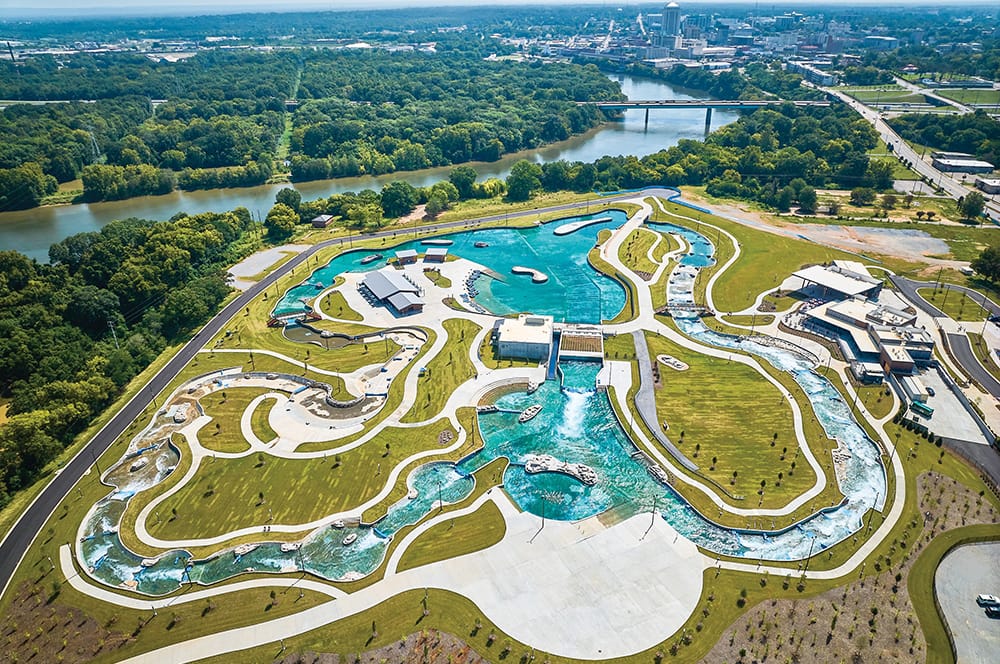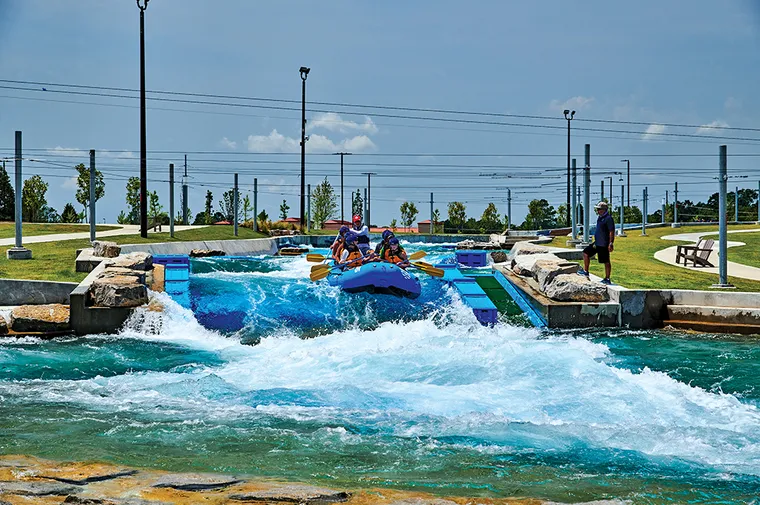Montgomery plunges into whitewater as development tool to expand regional narrative
By John Bricken and Max Vaughn
Ask recreationalists to name some of the top whitewater kayaking areas in the United States, and images of the New River Gorge in West Virgina, Salmon River in Idaho, and even the Ocoee River on the Tennessee-Georgia border come to mind. Now, Montgomery, Ala., is emerging as a new site for recreationalists to visit.
For a city known more as the birthplace of the Civil Rights Movement, where top tourist attractions include the National Memorial for Peace and Justice and the Legacy Museum, sites like Maxwell Air Force Base and a Hyundai manufacturing plant also classify Montgomery as part of the New South. The city has diversified its economy and, as a result, its fortunes.
Sitting along the banks of the Alabama River and at the confluence of two major southern corridors with interstates 65 and 85, Montgomery is advantageously situated at the intersection of culture and economic growth.
And now, it can add to its narrative as a place for recreation with a state-of-the-art, whitewater kayaking course.
Montgomery Whitewater opened in summer 2023 as only the third manmade whitewater course in the nation, joining the U.S. National Whitewater Center in Charlotte, N.C., and the Oklahoma City Whitewater Park. With a course designed by world champion and Olympic competitor Scott Shipley, Montgomery Whitewater already played host in April to the U.S. Canoe Slalom & Kayak Cross Olympic Team Trials for the Paris games.
For whitewater enthusiasts looking for challenges and fun on class II, III, and IV rapids, the course’s spot on the map was only part of the vision for the $75-million development. Located in a long-overlooked and economically depressed part of the city, Montgomery Whitewater is seen as a catalyst for economic development and a tool to enhance the perception of what’s expected from this historic southern city.
A Community Project With Big Dreams
Former Montgomery Mayor Todd Strange described Montgomery Whitewater as critical to projecting a positive image of the community, as a place not only for professionals but also for outdoor enthusiasts of all ages and that could improve the lives of residents, workers, and tourists alike.
“Montgomery County invested [in] itself, envisioning an improvement in the quality of life for its residents through the Whitewater project,” says Jeffrey Gustin, CEO of Montgomery Whitewater.
Former Montgomery Commissioner Elton Dean, who has since passed away, was instrumental in driving the plans forward for this project, especially when others were unsure of the benefit it could bring to the city. Since his passing, Montgomery County Commissioner Doug Singleton and other local leaders have carried the project’s torch in his stead.
“Honesty about goals, coupled with realistic timeframes, is essential. These projects are marathons, not sprints, and require local champions to carry the banner along the way,” Gustin says.
Through that lens of community impact, the project came together as a coordinated effort between multiple city, county, and economic-development authorities who contracted with an organization, the Southern Whitewater Development Group, to bring this project to life.
It was this community support that helped make the vision proposed eight years earlier a reality. Called “Project Catalyst,” Montgomery Whitewater was conceived to leverage the natural beauty of the site near the Alabama River to provide people with a premier destination for outdoor recreation, events, and entertainment. Even before opening, the local Chamber of Commerce began recruiting tenants to visit site parcels for possible operations like hotels and retail stores.

Maxwell Air Force Base, located directly west of the site, was instrumental in securing property. Part of the project extends onto the base property, requiring modifications like relocating a security fence to enable shared access. Maxwell AFB is a cornerstone of the Montgomery community, and its ongoing support is vital to the city’s growth. This new facility will also serve as a valuable recreational and entertainment resource for those stationed at Maxwell, enhancing the quality of life for its personnel.
It’s the type of development that attracts political support. Transformative in its vision, Montgomery Whitewater is predicted to increase the quality of life in the River Region—the area where Montgomery is located—and drive economic development, support the military, and recruit and retain professionals in the area.
This is not to say that all political support equates to community support. In fact, selling the idea of a whitewater park to area residents proved challenging when most people’s image of a waterpark includes splash pads and slides. However, through well-planned and decisively executed community meetings and outreach activities, the community began to see the potential of this recreational amenity as more than just a kayak course but also as a hub for community gatherings, concerts, and trails, and as a host to tournaments that attract people from around the nation.
“Educating people about what Whitewater is—and what it’s not—has been one of the biggest challenges. It’s not a typical waterpark; it’s recreation with purpose, attracting everyone from Olympic athletes to beginners,” says Gustin.
Providing channels for feedback and comments also welcomed the community into an inclusive project that gave them some ownership. Ideas like rock walls, ziplines, rope courses, and on-site camping became elements included in the master plan as the site developed.
A Canvas For Designers And Engineers
For anyone familiar with the geography of central Alabama, the thought of any type of whitewater rafting or kayaking can sound unique for a region of the United States known more for its rivers of commerce and genteel lifestyles.
With the coalition of political and community support, though, the land proposed to host Montgomery Whitewater presented the project team with a blank slate on which to design and engineer a world-class whitewater facility.
“If you’re going to do something, do it right. The vision for Montgomery Whitewater was, and continues to be, for an exciting, innovative, and unique development for the entire region. We’ve stayed committed to that vision to ensure every visitor enjoys a first-class experience,” says Leslie Sanders, Vice President, Southern Division, Alabama Power Company.
While located on the banks of the Alabama River, the park sits on actual land rather than on a riverbed. Two winding cast-concrete channels shape the course, providing an 18-foot elevation drop with 12 million gallons of filtered water pumped into the channels. Channels are a maximum of 10 feet deep, with the width varying to create the different whitewater challenges. Rails in the channel beds allow artificial features to be placed and moved to create an ever-changing course.
The engineering gave designers multiple options for landscaping and programming. With the pump located underground, designers can create pathways over the pump station, guiding people from registration to the raft building. With the Alabama River bordering the park, the natural landscape provided designers a canvas to plan for an extensive trail system connecting visitors to the river.
The whitewater course also gave the project team an amenity to place community gathering space, not only for spectating but also for events. The main facility is elevated to give people great views of the channel, with a large canopy roof and open-air space that make users feel part of the whitewater park. An outdoor patio is located proximate to the whitewater course, close enough to feel the spray of the water.
Working with the civil engineers and whitewater course designer, the project team created a master plan that includes a hotel, retail, and other businesses immediately adjacent to the development to bridge the recreational areas with the main transportation corridor to the park.
Many of the programmed spaces were determined by the channel design, but the blank slate gave designers opportunities to enhance the project with walkways, hardscapes, and landscaping. When mature, the landscape will provide residents and visitors with a beautiful natural escape from the urban environment.
“We knew the whitewater channels would be the most technologically advanced water project in the world. What’s more, the vision was to join incredible whitewater rafting with first-class dining, an entertainment venue, zip lines, ropes courses, and walking trails,” says Sanders. “Montgomery Whitewater is also providing unique STEM and environmental education programs to hundreds of students.”
Reimagining a region’s reputation is not an easy task, especially one that is steeped in history. Yet, Montgomery Whitewater is showing what a region is capable of when the right parties coalesce around a vision that doesn’t change a narrative but adds to it.
Analysis of Montgomery Whitewater predicts the development project will attract about 300,000 visitors annually and generate more than $35 million in economic activity. From a tourist perspective, for a city that has traditionally been a conduit for families going to the Gulf Coast for vacation, Montgomery Whitewater now gives them a reason to not only stop but also stay for an unexpected experience.
“Projects like these not only give the community what it wants but also what it needs. They grow with the community, reflecting and reinforcing its identity,” says Gustin.
More importantly, for residents of the River Region, it provides them with a new amenity that adds to their quality of life and redefines what it means to live in a river city.
The Right Coalition To Drive Vision
With only two manmade whitewater parks in the United States for Montgomery city and county officials to use as a model for development, bringing Montgomery Whitewater to life required more than a solid vision. It required the right players at the table to come together around the vision.
The site itself, within the city of Montgomery, was long underserved and depressed. With more than 100 parcels of dilapidated buildings on the site, the project required money and coordination to clear the site and reshape it for development.
“This project is about quality of life and quality of place. It’s about healthy, outdoor recreation and educational opportunities. It has also become an effective tool in demonstrating to potential businesses that the Montgomery region is committed to being a place where employees and their families will enjoy working and living. The most exciting days for Montgomery Whitewater are still to come,” says Sanders.
Coordinating the effort among vested parties, the Montgomery County Community Cooperative District was created to bring together the interests of the city, county, and state to serve as the ownership entity of the facility. Southern Whitewater Development Group was chosen to both develop and operate the new whitewater center, having designed, developed, and operated the most successful whitewater projects in the world.
State authorities also joined the unprecedented partnership, and Alabama Power worked with the designers and engineers to make the engineering designs robust enough to power the project.
Montgomery Area Chamber of Commerce officials are also involved, leveraging the development to promote the region and attract new businesses and residents.
John Bricken, PLA, ASLA, LEED GA, has been with Goodwyn Mills Cawood (GMC) since 2006 and is the Executive Vice President of Landscape Architecture and serves on the Board of Directors.
Max Vaughn, PE, currently serves as Vice President of Engineering at GMC and has over 20 years of experience. He has managed and designed civil-engineering projects.

